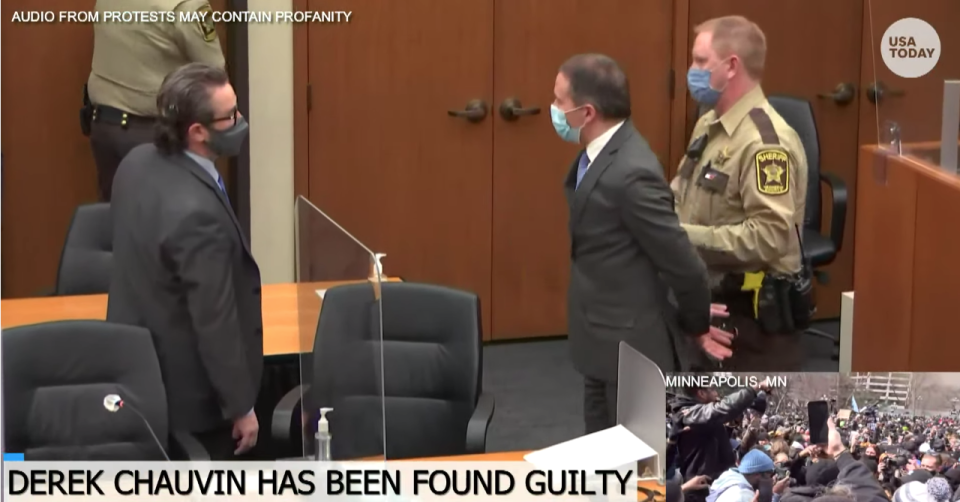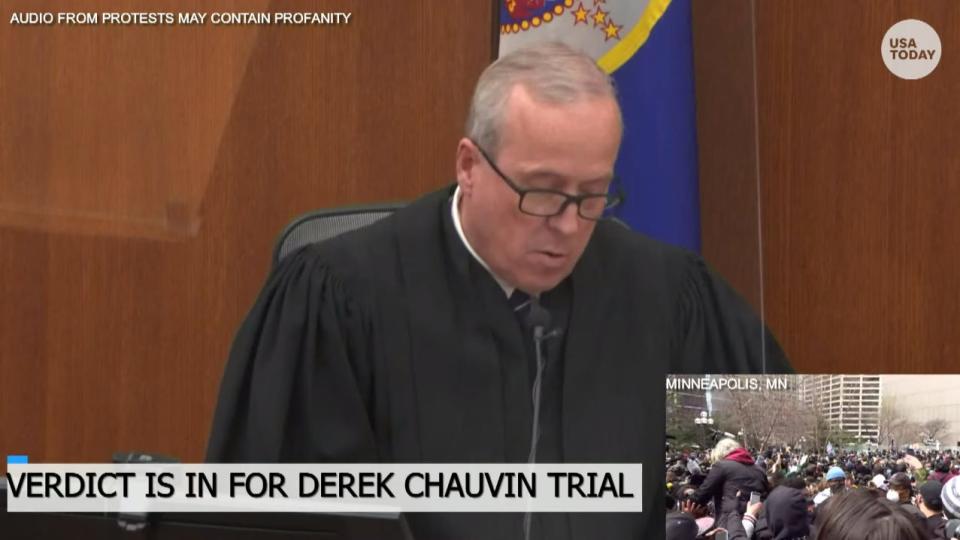The pandemic forced judges to let livestream cameras into court. The Chauvin trial showed it could work. Will it last?
Nearly 22.8 million Americans watched last month as a Minnesota jury found former police officer Derek Chauvin guilty of murdering George Floyd with a knee on his neck.
Hundreds of thousands of people listened to livestreamed audio last year as the Supreme Court heard arguments over whether then-President Donald Trump's tax returns should be turned over to investigators.
Even less well-known cases are drawing keen public interest. Roughly 350 people watched via Zoom on Tuesday as former nursing assistant Reta Mays was sentenced in federal court to seven life terms in prison for using insulin to murder aging patients in a West Virginia VA hospital.
Little more than a year ago, these sights and sounds would have been unavailable to anyone outside the courtroom. But the COVID-19 pandemic has accomplished what years of efforts by advocates for criminal justice system transparency could not: It has thawed historic opposition to widespread use of cameras and microphones in courts.

Scott Tufts, senior vice president of Court TV, a multi-platform network seen on television, online and on mobile apps, and which handled the livestream of the Chauvin trial, said that case and others represent "a turning point, for sure" in efforts to expand electronic coverage of court proceedings.
'They need to be watched': How livestreaming the Derek Chauvin trial lets people of color monitor the justice system
"Federal courts are famously behind the times on technology, so it was always going to take an earth-shattering event, like a pandemic, to bring them up to speed," said Gabe Roth, executive director of Fix the Court, a nonpartisan organization working to make courts more accountable to the American public.
Before the pandemic hit, state and municipal courts had a mixture of rules on cameras. "Some states, like Florida and Texas, have been great on allowing cameras, and others, like New York and Alabama, have been pretty awful," said Roth.
Public access vs. the right to a fair trial
The debate over cameras in courts focuses on a balancing of two U.S. Constitution safeguards. The First Amendment gives the public and the press access to most criminal trials. The Sixth Amendment gives defendants the right to a public trial, one where the presence of spectators helps ensure fairness.
But in some high-profile cases, failure to limit public and media access promptedallegations that defendants' right to a fair trial had been violated. Conversely, overly zealous restrictions on access have raised claims of First Amendment violations.
Many U.S. lawmaking bodies have barred or restricted cameras in courts, with agreement from judges. The arguments against cameras: Still photos or video could obstruct the proceedings. Attorneys might grandstand. Juries could be intimidated or improperly influenced. And laws governing court procedures bar recordings because there is supposed to be a single, official record.
The nation's top court nixes cameras: Cameras in the Supreme Court? Not anytime soon
State-by-state-guide: Are cameras permitted in your local and state courts?
Changes at the nation's highest court?: Biden's Supreme Court commission faces resistance
Exhibit A for opponents of electronic coverage has been the televised 1995 murder trial of former NFL star O.J. Simpson in Los Angeles Superior Court. Dubbed the trial of the century, it drew heavy media attention and a viewing audience in the millions.
In an outcome that's still debated, the trial ended with Simpson's acquittal on charges he murdered his wife, Nicole Brown Simpson, and her friend, Ron Goldman. To some, the trial came across more like a TV drama than a real-life criminal proceeding.
The debate over cameras in courts led to a pivotal ruling by the nation's highest court in a case titled Chandler v. Florida. The Supreme Court affirmed the convictions of two Miami Beach police officers who argued the presence of a camera during their proceeding had denied them a fair trial. The ruling said nothing in the Constitution bars state and local courts from broadcasting trials.
Now procedural laws of state courts in all 50 states allow at least some electronic coverage of trials. However, federal criminal trials largely have remained off-limits. Federal appeals courts, where hearings typically don't involve witnesses, have allowed some electronic coverage.
COVID-19 and the Chauvin trial
The pandemic changed everything.
Many courthouses were virtually locked down for months. The closures delayed trials across the nation. Only the most essential proceedings, such as arraignments, were held, mostly via video. Even U.S. Supreme Court justices have conducted hearings from their homes or offices via video and audio.
The Chauvin case, arguably the most widely followed U.S. criminal proceeding since the O.J. Simpson trial, posed a major test. Hennepin County Judge Peter Cahill weighed whether to allow cameras in a courtroom where COVID-19 safety precautions could accommodate only a handful of journalists and family members, but no spectators.
Cahill had to consider a Minnesota law that said cameras may be allowed in trials when attorneys for both sides consent and the judge approves it. Chauvin's legal team, led by Eric Nelson, agreed. The prosecution, led by Minnesota Attorney General Keith Ellison, said no and instead suggested sending a video feed to another courtroom.
Overruling the government's objections, Cahill authorized Court TV to install three cameras in the courtroom under strict regulations. They included a ban on showing members of the anonymous jury and any children who testified.
"This court concludes that the only way to vindicate the defendant's constitutional right to a public trial and the media's and public's constitutional right of access to criminal trials is to allow audio and video coverage," Cahill ruled.
The Court TV cameras provided a livestream that was carried by media organizations worldwide and was seen not just on TV, but on computers and phones.
The trial has been hailed as a textbook argument for more cameras in courts, with similar restrictions. Lawyers did not grandstand. Witnesses and jurors testified and listened, without any sign they were intimidated. In short, it looked like a typical, though high-profile, criminal trial.

"Cameras in the Hennepin County courtroom didn’t tilt the scales of justice, disrupt court proceedings or infringe on due process of the accused," Sen. Chuck Grassley, R-Iowa, a longtime advocate for cameras in courts, wrote in a recent USA TODAY essay.
"If anything, the live feed delivered unfiltered assurance to the American people," he wrote. "It showed our system of justice at work and affirmed the independence of the judiciary as an impartial arbiter of the rule of law."
Even Ellison, whose office tried unsuccessfully to overturn Cahill's ruling on cameras, was at least partly swayed.
"Things went better than the way I thought they were going to," Ellison said during a post-trial interview on WCCO-TV in Minneapolis. "I thought it would alter the way lawyers handled the case and handled evidence. But it went pretty well."
Live, from a federal courthouse near you
Before the pandemic, just two of the 13 mid-level federal appeals courts allowed audio livestreaming of legal arguments. The Supreme Court released audio recordings of hearings at the end of each week, too late to be of much use to news organizations. And federal district courts, where trials are conducted, do not allow any recording, photography or livestreaming of criminal proceedings.
Now, all 13 of the mid-level appeals courts have livestreams, and so does the Supreme Court. Although there still is no video camera in the high court, Court TV carried livestream audio of its hearings on Trump's tax returns, accompanied by expert legal and tax commentary.
More recently, Court TV ran live audio from Supreme Court arguments in the case of Brandi Levy, a Pennsylvania teen who argues she was unfairly punished by her school for a profanity-laden social media post after she wasn't selected for the varsity cheerleading team.
"If you had told me five years ago we could put that on Court TV, I would have said you were crazy," said Tufts, the company's senior vice president.
Along with giving listeners insights about pending Supreme Court cases, Tufts said the live audio has shown something about the court itself. Associate Justice Clarence Thomas has often refrained from joining the justices' free-for-all questioning of attorneys during in-person hearings. However, he has regularly asked questions during the audio livestreams, where the justices ask questions in order of seniority, Tufts said.
For Mays' sentencing this week, a Zoom link was available in several places — on the court's website, in a scheduling order, in a news release — and was provided to victims' families, among others, said Stacy Bishop, a spokesperson for the U.S. Attorney's Office for the Northern District of West Virginia.
"The public would have access, if they knew where to look," on the court website and in the judge's order, Bishop said.
Among the people who viewed the proceeding were a woman petting her dog, people sitting in their living rooms and someone who watched as she prepared and ate her lunch.
Looking beyond the pandemic
Will the gains in electronic access continue, and even expand?
Roth said he urged federal appeals courts' staff to commit to livestreaming legal arguments after the pandemic. While none have decided, the fact that the audio has continued so far "bodes well for the fall," he said. He also hopes to convince the Supreme Court to keep its audio livestreams when its next term opens in October.
"It's my hope that judges and advocates see the transparency benefits brought on by livestreaming, not to mention the cost savings and scheduling improvements," Roth said.
Fifteen federal district courts are participating in a two-year audio livestreaming pilot project that began in February. It allows audio streaming of civil matters of public interest on a court's YouTube channel if all parties in the case consent and the judge approves.
Second trial delayed: Judge postpones trial for 3 former Minneapolis police officers charged in George Floyd’s death
In state courts, Court TV is showcasing its Chauvin coverage as a model for livestreams of future trials, Tufts said. That includes the rescheduled March 2022 trial of three other former Minneapolis police officers charged in Floyd's death.
But courts frequently remain bound to tradition.
"Far too many judges feel cameras in courts will have a detrimental effect on the criminal justice system," said Dan Shelley, executive director and CEO of the Radio Television Digital News Association.
This article originally appeared on USA TODAY: COVID brought cameras, Zoom to courtroom, Chauvin trial: Will it last?

 money
money 